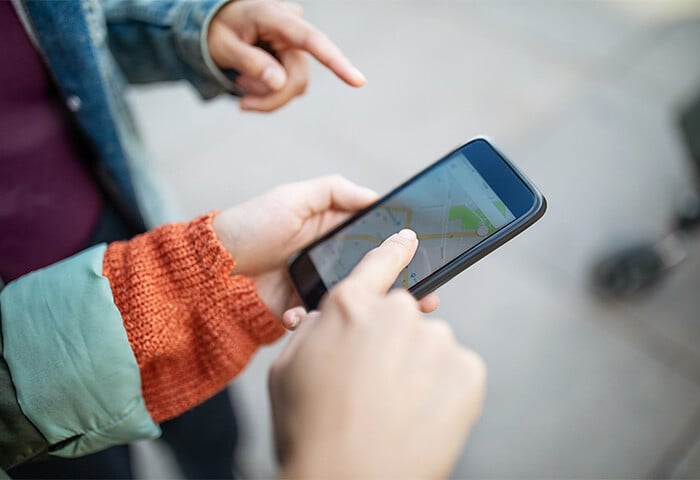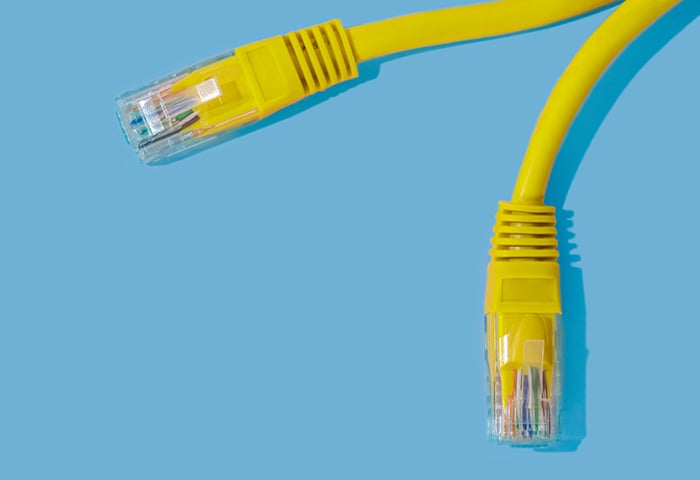How to change your IP address automatically
You can change your device’s IP address automatically by connecting to a VPN or a proxy server. Your device’s IP address will change, but the IP address for any other devices on your network won’t. Changing your device’s IP address through a VPN or proxy doesn’t affect your router settings either.
Don’t worry about what happens if you change your IP address. An IP is like the address to your house — it’s just a number that lets others know where you are. Changing your IP address is like changing the number on your mailbox: you'll confuse strangers, but your friends will still know how to reach you.
Change your IP address with a VPN
Changing your IP address with a VPN is one of the easiest ways to keep online trackers off your trail. Here’s how to do it:
-
Install a reliable VPN like AVG Secure VPN.
-
Open the app and toggle on the VPN. Your device’s IP address will change and you’ll be connected to the fastest server location available.

Here are some pros and cons to consider when changing your IP address with a VPN:
Pros to using a VPN:
-
Lets you browse anonymously.
-
Secures traffic data to and from your device.
-
Helps you bypass geo-blocked websites and access content.
-
Encrypts your internet connection.
-
Prevents internet throttling from your ISP.
Cons to using a VPN:
-
Slows your normal internet connection speeds.
-
Some websites don’t allow access with a VPN.
-
If the VPN is untrustworthy, it may collect your data.
A quality VPN allows you to change your IP address location to almost anywhere in the world, and it will find the best server location possible. However, a VPN connection might be a bit slower than your usual internet connection, because the traffic coming in and out has an extra layer of protection to get through.
You can change your IP address by using a VPN on Windows and Android, and you can set up a VPN on Mac and iOS devices just as easily.
Change your IP address with a proxy server
While a VPN is like changing your house number, a proxy server is like setting up a safehouse to communicate on your behalf. The website server sends information to your safehouse (the proxy server) instead of to your device directly. The safehouse then forwards the information to your real address.
Pros to connecting via proxy:
-
Unlocks geo-blocked content or sites blocked at work or school.
-
No installation necessary.
-
Strengthens the security of your network connection.
Cons to connecting via proxy:
-
Doesn’t encrypt your connection.
-
Crowded proxy servers can cause slow internet speeds.
-
Some untrustworthy proxies can reroute you to unsafe websites or collect your data.
After you get comfortable setting up a proxy or using a VPN to change your IP address, you can experiment with different configurations and uses, such as using a Smart DNS proxy server vs a VPN.
How to change your IP address manually
Learning how to change an IP address manually allows you to make permanent changes to your device’s virtual location. Or you can change between a static IP address — which is great for remote workers or gamers that use Zoom or other VoIP services — and a dynamic IP address that keeps hackers guessing.
Changing your IP manually can be tricky. But if you decide to change your IP address on your own, it’s best to choose an IP address between these ranges:
-
10.0.0.0 – 10.255.255.255
-
172.16.0.0 – 172.31.255.255
-
192.168.0.0 – 192.168.255.255
You’ll also want to avoid IP addresses outside the range of your current network. And don’t change your IP address to numbers that end with .0 or .255. These are usually reserved for TCP/IP protocols. Numbers commonly used by a router or other network device, such as 10.0.0.1, 192.168.0.1, or 192.168.0.100 are easy targets for dangerous hackers.
Change your IP address in Windows 10
Here’s how to change an IP address in Windows 10:
-
Go to the Windows Start menu > Settings.

-
Select Network & Internet.

-
Click Edit under IP settings to change your IP assignment.

-
Under Edit IP settings, select Manual from the drop-down menu. Toggle on IPv4. Then enter your IP address manually.

Change your IP address on Mac
Here’s how to change an IP address on Mac:
-
Click the Apple logo in the menu bar. Select System Preferences > Network.

-
Select your Wi-Fi network. In the bottom right, click Advanced.

-
Click TCP/IP. Under Configure IPv4, select Manually.

-
Next to IPv4 Address, enter your desired IP address. Click OK to confirm.

Change your IP address on Android
Here’s how to change an IP address on Android:
-
Open Android Settings. Tap Connections > Wi-Fi.

-
Next to your network, tap Settings (the gear icon) to open network settings.

-
Tap IP settings and select Static. Enter your desired IP address and tap Save.

Some developers have learned how to change an IP address on Android without a VPN. Google Play is full of IP changer apps, but make sure you practice Android app safety before you install and use any unknown apps.
Change your IP address on iOS
Here’s how to change your IP address on an iPhone or iPad:
-
Open Settings. Tap Wi-Fi, then choose your network.

-
Tap Configure IP.

-
Select Manual, then enter your desired IP address.

Other ways to change your IP address
Other ways to change your IP address include using the Tor Browser or resetting your internet router. Both are legal, though many ISPs take notice if you use Tor regularly due to its connection to dark web marketplaces. Resetting your router is as simple as unplugging it and plugging it back in again.
Use Tor to change your IP
Tor encrypts your IP address and internet traffic to hide the data you send and receive. Your identity is hidden by bouncing the data packets you send around many different Tor servers. Here are some pros and cons of using Tor Browser.
Pros to using Tor Browser:
-
Hides your IP address and real location.
-
Blocks online tracking.
-
Allows you to access the dark web.
-
Tor is maintained in a decentralized structure, so no one controls the browser’s data.
-
Browser patches are often released quickly due to its open-source nature.
Cons to using Tor Browser:
-
Attracts a shady user base.
-
Significantly decreases internet connection speeds.
-
Is rife with unsecured websites.
-
Is vulnerable to packet sniffers.
Regardless of Tor Browser’s association with the dark web’s illicit sites, check out the differences between a VPN, a proxy, and Tor and experiment with how to change your IP address in a way that works best for you.
Reset your router to change your IP
You can change your IP address by simply unplugging your router, waiting a few minutes, then plugging the router back in. You may have to repeat the steps multiple times before you get lucky and obtain a new IP address from your ISP. This will change the external IP address for all devices connected to the network.
You can also change a router’s IP address manually by logging into it. Check the list of default router information for more about manually changing the external IP address of your router — default IP addresses and login information differ depending on the router manufacturer.
Here are the general steps for how to manually set your IP address on a router:
-
Enter your router's IP address into your browser.
-
Log in with the default username and password.
-
Choose Network Settings, Administrator Settings, or a similar option.
-
Go to the Router Settings and type in the router's new IP address.
-
Save and exit.
Pros to resetting your router:
-
May improve internet connection speeds.
-
Reloads the router’s OS and clears the memory.
-
Can help prevent ISP throttling.
Cons to resetting your router:
-
Rebooting your router may not change your IP address.
-
Can disrupt the internet connection of other devices connected to your network.
-
Doesn’t encrypt your connection.
What is an IP address?
An IP address is a string of numbers that uniquely identifies any device or network connected to the internet. IP addresses are how internet traffic is accurately routed, and how computers recognize each other to send and receive information.
IP addresses can also be categorized into public vs private IP addresses — which refer to the IP addresses that communicate with the larger internet vs those that talk only within your local network, respectively — as well as IPv4 vs. IPv6. Knowing how to change IPv4 to IPv6 can also make your internet communications much more efficient.
On a PC or Mac, you can find your current IP by Googling “What’s my IP address.” On an Android or other mobile device, open your Wi-Fi settings to check your IP address. And, for anyone keeping tabs on you, it’s almost as simple. That’s why learning how to hide your IP address will help strengthen your online privacy.
Why change your IP address?
Changing your IP address makes it harder for cybercriminals to find and track you, and it helps you unblock certain websites and streaming services. Changing your IP address is also a good way to bypass ISP throttling if you suspect your internet is being slowed down on purpose.
If you can find your IP address, then hackers, scammers, and social media companies likely know how to get your IP address too. And even though your IP address can change with your location, as you move around it becomes easier to learn your device’s whereabouts. And while at home, your IP doesn’t change, so with a little detective work cybercriminals can quickly figure out which IP addresses are home addresses.
Our private browsing guide can show you a few steps toward total browsing freedom. But if private browsing and online privacy are important to you, changing your IP address will be a game changer.
Protect your privacy online with AVG Secure VPN
No matter what your reason is for changing your IP address, there are some ways to do it that are more secure than others. AVG Secure VPN hides your activity from hackers, scammers, and your ISP — all while encrypting your internet connection.
Advertisers can’t find you, and the government can’t spy on you. Watch anything, anywhere, anytime. Send payments securely and become invisible as you browse. Try AVG Secure VPN for free today and enter your own private browsing universe.




























